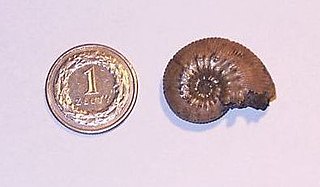Abbasites is an extinct genus of ammonites from the early Middle Jurassic epoch, included in the ammonitid family Erycitidae.
Kamerunoceras is an extinct cephalopod genus belonging to the ammonite family Acanthoceratidae, found in Upper Cretaceous formations of Africa, Europe and North and South America.

Acanthoceratidae is an extinct family of acanthoceratoid cephalopods in the order Ammonitida, known from the Upper Cretaceous. The type genus is Acanthoceras.

Kosmoceras is a moderately evolute ammonite genus from the upper Callovian of Europe with a simple aperture and irregular ribbing interrupted by an irregular row of lateral tubercles. Strong ventral tubercles are separated by a smooth depression running along the rim.
Ancyloceratoidea, formerly Ancylocerataceae, is a superfamily of typically uncoiled and loosely coiled heteromorph ammonoids established by Alpheus Hyatt in 1900, that may contain as many as 11 families, depending on the classification accepted.
Ceratitoidea, formerly Ceratitaceae, is an ammonite superfamily in order Ceratitida characterized in general by highly ornamented or tuberculate shells with ceratitic sutures that may become goniatitic or ammonitic in some offshoots.

Acanthoceratoidea, formerly Acanthocerataceae, is a superfamily of Upper Cretaceous ammonoid cephalopods belonging to the order Ammonitida, and comprising some 10 or so families.

Tetragonitidae is a family of Cretaceous lytoceratin ammonites typically with square or trapezoidal whorl section at least during some growth stage. Members of this family are usually smooth but some lirate or striate, often with constrictions. Other features include suture with a varying number of auxiliary saddles, and an internal suture with two or more. Major saddles are irregularly trifid. The family is derived from the genus Tetragonites.

Berriasellinae is a subfamily of very late Jurassic and very early Cretaceous perisphinctoid ammonites in the family Neocomitidae. Berriasellinae comprises generally compressed, evolute genera, typically with furcated ribbing, and in some a smooth ventral band or groove. Berriasellinae are derived from the Ataxioceratidae and gave rise to the other Neocomitidae. The short lived Himalayitidae from the uppermost Jurassic have a similar appearance but differ in being generally broader and having sharper ribbing.
The Haploceratidae is the type family of the Haploceratoidea, a superfamily in the ammonitina; which according to Donovan et al. (1981) can be derived from the Taramelliceratinae, a subfamily of the Oppeliidae.

The Ptychitidae is a family of ceratitid ammonites. They are combined with the Eosagenitidae and Sturiidae in the superfamily Ptychitoidea.
Sirenites is a genus of ammonoid cephalopods from the Upper Triassic included in the Ceratitida, and type for the trachyceratid subfamily Sirenitinae.

Gymnitidae is a family of Lower to Middle Triassic ammonite cephalopods with evolute, discoidal shells.

Perisphinctidae is a family of Middle and Upper Jurassic discoidal ammonites in the order Ammonitida. They have a shell morphology that is mostly evolute, typically with biplicate, simple, or triplicate ribbing. Large forms have simple apertures and smooth body chambers while small forms have lappets and ribbed body chambers.
The Hungaritidae comprises a family of ceratitid ammonites described in the Treatise,(Arkell et al. 1957), as involute compressed, discoidal, with keeled or sharpened venter, smooth to weakly costate. Sutures ceratitid, usually with numerous elements.
Cunningtoniceras is a stocky acanthoceratid ammonite from the upper Cenomanian stage of the late Cretaceous of the western U.S., found e.g. in Arizona and New Mexico.
Euomphaloceras is an early Upper Cretaceous ammonite genus,, included in the Acanthoceratinae until established as the type genus for the Euomphaloceratinae by Cooper, 1978.
Romaniceras is a genus of Upper Cretaceous ammonites in the Acanthoceratidae subfamily Euomphaloceratinae.
Phlycticeratinae is an ammonite subfamily included in the Oppeliidae established for the genus Phlycticeras. Although there seems to be some affinity with Stephanoceratoidea it is most likely descended from some bathonian member of the Oppeliinae.
Erycitidae is a family of Lower and Middle Jurassic ammonites included in the Hildoceratoidea. The hammatoceratid subfamily Erycitinae is equivalent. Genera include Erycites (type) and Abbasites.






